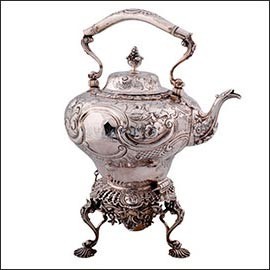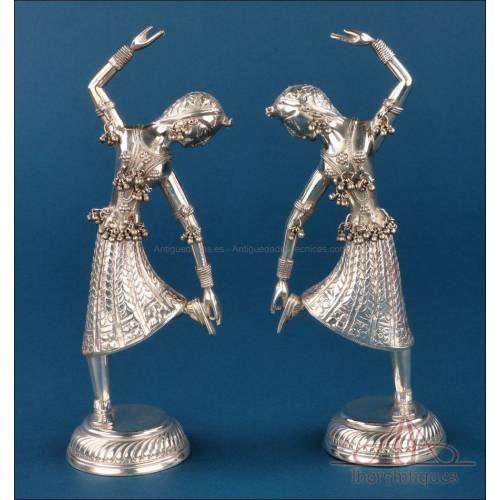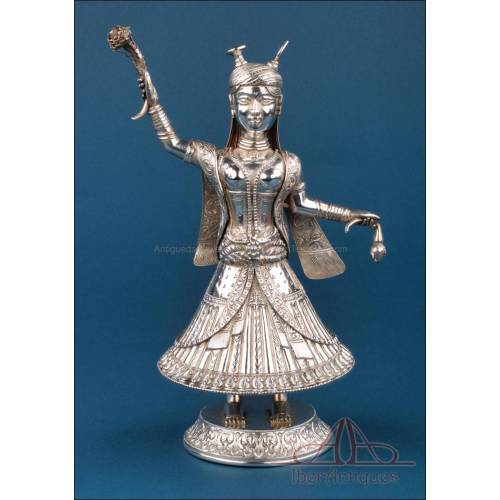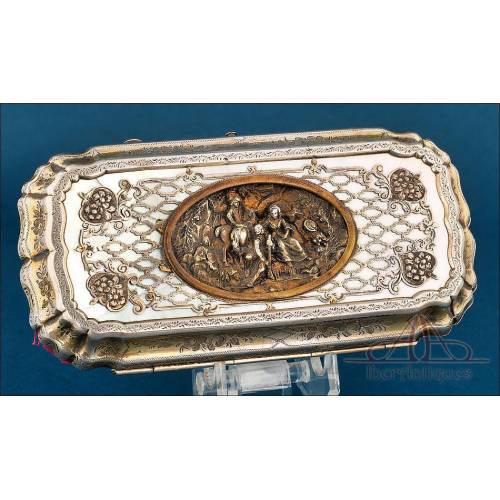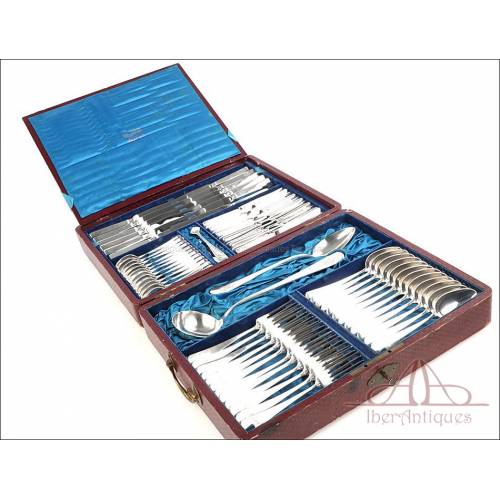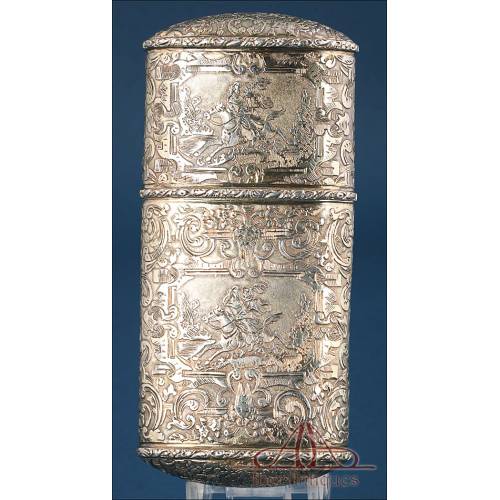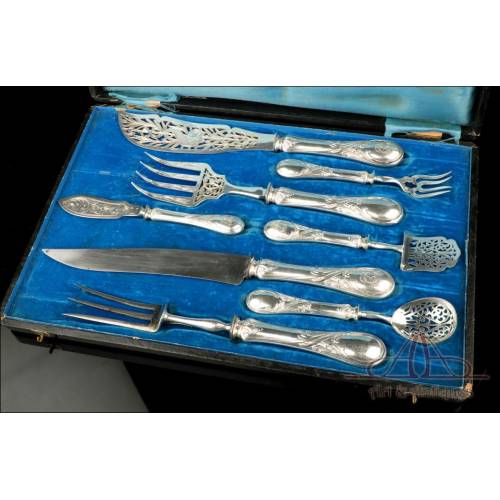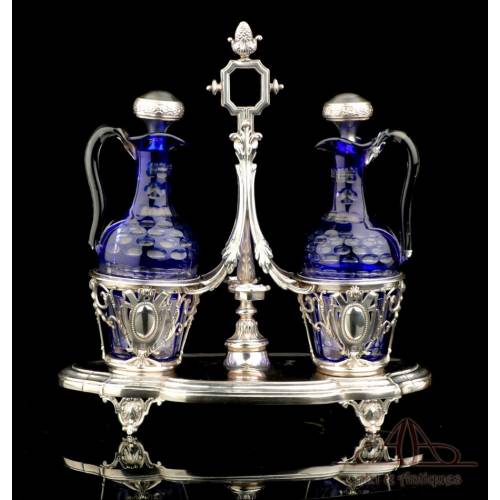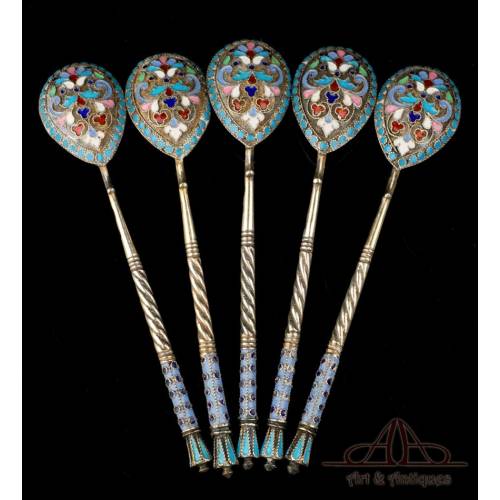Silver Antiques
Silver antiques and objects made in antique silver are very sought after and sought after by collectors interested in precious metals. In Spain, silver work experienced a great boom after the Discovery of America. The large quantities of silver and gold that arrived from the New World generated a very important goldsmith industry, which made th...
Silver antiques and objects made in antique silver are very sought after and sought after by collectors interested in precious metals. In Spain, silver work experienced a great boom after the Discovery of America. The large quantities of silver and gold that arrived from the New World generated a very important goldsmith industry, which made the silversmith trade reach high levels of perfection and detail. On the other hand, the strong influence of the Catholic Church motivated the creation of magnificent silver antiques, giving rise to a large number of beautiful objects designed for liturgical, ritual and ornamental uses.
Among the antique silver pieces in our collection we have all kinds of items, mostly contrasted and with fantastic decorations, dated up to the 40s of the twentieth century. We can also highlight some pieces of silver plated metal, which retain their appeal intact to this day.
Brief history of goldsmithing and silversmithing.
Goldsmithing is the art of manipulating precious metals (gold, silver and platinum) to create jewelry and decorative objects. Silversmithing is the part of goldsmithing that is dedicated exclusively to working in silver and silver-plated metal. Ancient goldsmithing has its roots in the Neolithic period (6,000 - 3,000 B.C.), when ornaments and pieces of copper and bronze began to be made. Precious metals such as gold and silver began to be used by the Assyrians and Persians, who used them to make all kinds of functional objects (tableware, vessels...) and as ornamentation for carriages, saddles, furniture, etc. These objects were intended for important personalities, such as kings and nobles. Ancient Egypt also developed goldsmithing thanks to the influx of gold from the Nubian mines. In other areas, the Celtic culture also stood out for the skill of its goldsmiths in working gold and ancient silver.
Regarding silver antiquities, the earliest known pieces are two silver scrolls with a priestly blessing found in a Jerusalem burial site. They are dated to around 600 BC. Throughout classical antiquity (Greece and Rome), goldsmithing and silversmithing developed together; by the Middle Ages a separation between the two was established. During this period, silver antiques acquired a religious meaning, with a large production of objects for the Catholic Church. In the Renaissance a new trend of profane inspiration arose: silversmiths dedicated themselves to creating tableware, vases, triptychs, weapon grips and all kinds of objects with vegetal ornamentation, especially in the classical style. In the Baroque period this trend continued, becoming increasingly complex and whimsical (especially in France).
In the nineteenth century the decorative arts follow two paths: on the one hand we find the neoclassical style, inspired by Greek and Roman; and on the other is the romantic style, free and inspired by legends, romances and myths. Goldsmiths and silversmiths are no strangers to these trends and reproduce them in their pieces. In the 20th century, antique silver pieces made up to the 1940s often adopted neo-Gothic, modernist or art deco-inspired tints. It is a period of splendor for all kinds of antique silver pieces: chalices, reliefs, pocket watches, tea or coffee sets, cutlery....
Silver antiques shine on sideboards, in antique display cases or as part of the finest collections of religious art or decorative arts. Their appeal does not diminish with age, but takes on new nuances: antique silver pieces add beauty and personality to every environment.
Pair of Indian dancer sculptures in 900 silver, c. 1960 Pair of Indian dancer sculptures...
Pair of 900 silver female figures inspired by classical Indian dance, beautiful handcrafted work from the 1960s. Pair of 900 silver female figures...
870,00 €Solid silver Hindu figure, deity or ritual dancer, India or Nepal, ca. 1960s Solid silver Hindu figure, deity...
Solid silver Hindu figure, possibly a deity or ritual dancer, finely crafted with floral details. India or Nepal, 1960s. Decorative and symbolic piece. Solid silver Hindu figure, possibly a...
1 600,00 €Antique Gilded Silver and Mother of Pearl Box, 19th Century Antique Gilded Silver and Mother...
Elegant 19th-century silver and mother-of-pearl box. Floral engravings and pastoral scene. Red fabric interior. Perfect for collectors. Elegant 19th-century silver and...
SoldComplete Silver Art Deco Flatware Set for 12. Barcelona, Circa 1920 Complete Silver Art Deco...
Gorgeous complete silver Art Deco flatware in its original storing case. With hallmarks and the silversmiths mark. Very beautiful set. Gorgeous complete silver Art Deco...
SoldAntique Solid Silver Cigar Case. Circa 1900 Antique Solid Silver Cigar Case....
Beautiful embossed silver cigar case in good condition. More than 150 years old. Beautiful embossed silver cigar case...
325,00 € 370,00 €Reduced price!Antique Silver Serving Cutlery Set, y Veyrat. Paris, Circa 1840 Antique Silver Serving Cutlery...
Wonderful serving cutlery set made by Veyrat. Original storing case. Complete and in striking condition. Wonderful serving cutlery set made by...
SoldAntique Solid Silver and Cobalt Glass Cruet Set. France, 19th Century Antique Solid Silver and Cobalt...
Beautiful solid silver and carved blue glass cruet set. Elegant turn-of-the-century design. In fine condition. Beautiful solid silver and carved...
SoldSet of 5 Enameled Russian-Silver Teaspoons. Russia, Circa 1900 Set of 5 Enameled Russian-Silver...
Antique set of 5 enameled silver teaspoons. Original from Russia. Gorgeous and in fine condition. Antique set of 5 enameled silver...
Sold
New products
-

Antique ivory and silver plated stethoscope, late 19th century
Antique stethoscope from the late 19th century in silver-plated metal...
-

Vintage pendant with shell cameo of Jesús del Gran Poder, carved c. 1970
Vintage pendant with a shell-carved cameo of Jesus del Gran Poder, circa...
-

Antique Roman Style Gilded Silver Chalice with Paten. France, 1932
Antique Roman-style chalice in gilded silver with paten. France, 1932....
-

Beautiful Antique 18 K Gold Ring with 7 Natural Diamonds
Antique 18K gold ring with 7 natural diamonds. Delicate openwork design,...
-

Antique Silver Reliquary. José Vilaplana. Valencia, Spain. Circa 1920
Impressive repoussé silver reliquary by José Vilaplana, Valencia, c....
-

Vintage 18K Gold Ring with 7 Natural Diamonds
Vintage 18K gold ring with seven natural diamonds in floral setting....
-

Antique Silver Chalice. Enameled Crosses. Valencia, Spain, 1942
Spanish chalice from 1942 in solid silver, gifted by the Church of...
-

Antique Silver Chalice and Paten. Granada Spain, circa 1900
Spanish chalice in white silver with matching paten, handcrafted....
Specials
-

Amazing Antique Carved Bull Bone Triptych. Valencia, Spain, Circa 1900
Exceptional carved bull-bone triptych...

